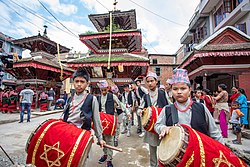Siddhipur सिद्धिपुर Thasi (थसी) | |
|---|---|
Village of Mahalaxmi Municipality | |
 Temple of Lord Ganesh & Lord Bhairav at Devnani, Siddhipur along with Dhaa: Baja of Siddhipur | |
 | |
| Coordinates: 27°38′46″N85°21′26″E / 27.6462080°N 85.3572940°E | |
| Country | |
| Province | Bagmati Province |
| District | Lalitpur |
| Municipality | Mahalaxmi Municipality |
| Ward | Ward No. 6 |
| Government | |
| • Type | Municipality Ward |
| • Ward Chairperson | Dharma Maharjan |
| • Socialist & Elected Ward Representative | Susan Maharjan |
| Population (2021) | |
• Total | 8,194 |
| Time zone | UTC+5:45 (Nepal Time) |
Siddhipur is a village and former Village Development Committee that is now part of Mahalaxmi Municipality in Bagmati Province of central Nepal. At the time of the 2021 Nepal census it had a population of 8,194 (Male: 4017; Female: 4177) living in 2009 individual households.
Contents
Siddhipur is a typical Newari community (87.49% of total population) where the spoken language is Newari (85.46% spoke Newari). The main occupation of the people living in this region is agriculture. Most of the people fully depend on the agriculture for their living. Siddhipur is also famous for sukul, which is a kind of handmade mat made of hay, a locally available material.

